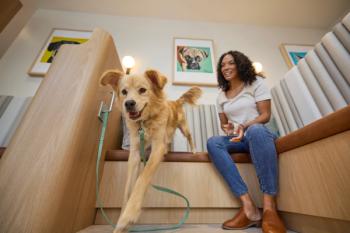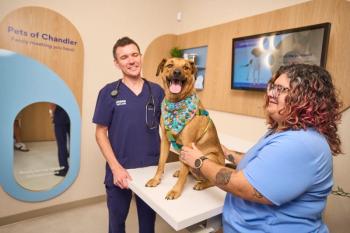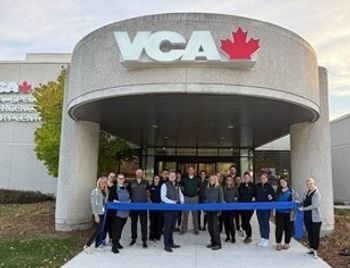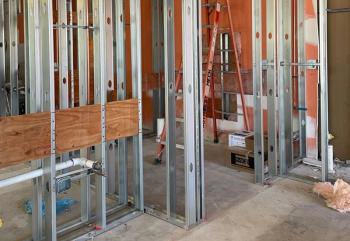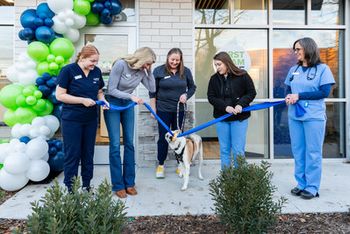
Hanging with Hafen: Shaping up your veterinary hospital's design
Learn the pros and cons to boxy vs. L-shaped designs, and discover the best shape for your veterinary hospital.
Most of the veterinary hospitals we design are all about the inside. This means creating the treatment room as the center of the universe and grouping everything around it to minimize steps and make all the adjacent rooms easily accessible and visible.
This often results in plans that are relatively square, or boxy. Let’s look at the plan of a typical veterinary hospital and do a lateral section. In the boxy hospital, the minimum lateral dimension would be approximately 55 feet. For example, in looking at an imaginary section you would see an office or break room on one side, next a hallway, then the treatment room. Adjacent to the treatment room on the other side of the building, you would see a surgery or X-ray room. Add up each individual room and you have a building that’s 55 feet thick—that’s really thick!
A benefit of a boxy, or thick plan, is that the surface area is minimized for the amount of contained space. For the most part, the cost of any building is driven by the amount of surface area, so there’s one reason to make thick buildings. Taking this to the illogical extreme, some of you might remember Buckminster Fuller and the geodesic dome that he invented. This was an extreme example of driving down costs by driving down surface area. A geodesic dome, very much like a soccer ball, has the absolute minimum surface area to volume of anything you can construct. Unfortunately most of the space is unusable because of the lack of horizontal space.
Another way to look at surface area is the old mouse vs. elephant analogy. A mouse expends a lot more energy per unit of weight than an elephant because of the elephant’s increased surface area. Your building potentially has the same issue.
The primary downside to boxy buildings, besides being boring, is that they are too thick to let light into the interior. With the current emphasis on green building design, we’re once again rediscovering the benefits of natural daylight and passive ventilation. The best way to accomplish these goals is with a skinny building.
But there are limits to how skinny a building should be and still be efficient in the way it’s laid out. The ideal blend of circulation and function is to create a central hallway with rooms to each side. As a building gets thicker and thicker, the design can accommodate a series of hallways with rooms to each side, laid down side-by-side. In contrast, it wouldn’t make sense to have a very skinny building with just a single loaded hall and adjacent rooms to one side. The hall would be a nice space, but you would end up walking gigantic distances to get from room to room.
Let’s look at a couple of real-life examples. On a few occasions we have worked with clients to create buildings with a lot of naturally lit spaces. Two examples of this are Dr. Lisa Carpenter’s Edinburgh Pet Health Center in Brooklyn Park, Minn., and Dr. Jan Cailles’s Oldewick Animal Hospital in Whitehouse Station, N.J. Visit their websites (
In both of these projects, the driving concept was twofold: wrap the building around, create an exterior space, and maximize the number of rooms with windows. Besides being willing to invest more money in a building with more surface area, both of these clients had the luxury of sites that were big enough to allow for a more spread-out building. Finally both of them were interested in investing in their outdoor space.
The floor plan above (
By wrapping the building around an outside space, you are creating an outdoor room. In the typical hospital, money is spent to enclose interior space, or the functional “working” areas of the hospital. But with an L-shaped building, you get the added bonus of creating exterior spaces or rooms that people can use. In the floor plan sketch, I’ve shown a semi-enclosed patio off of the consultation room and another patio off of the break room.
Additionally, the treatment area and the offices face into this landscaped area. The heart of the hospital is contained in the courtyard, not the building! This landscaped yard also sets the stage for the entry into the hospital.
> The reception desk is directly in front of you as you enter, and it is directly linked to the exam rooms.
> The waiting area is wrapped with windows on three sides. If you look at Dr. Cailles’s hospital on her website, you can see how all this daylight can really light up a waiting area.
> All of the exam rooms are flooded with light.
> The consultation room is special—it’s oversized with a fireplace and sits off of the landscaped yard. The outdoor patio can be used for quiet reflection or as an escape hatch for a distressed or grieving client.
> While it may not be what you expect, the pharmacy is in the public hall that leads to the exam rooms. (This would also be a good place for a display of all of the prescription diet food that you stock.)
> There’s a food storage closet adjacent to the front door, where it’s readily available for deliveries and for staff to carry food out to a client’s car.
> A special procedures room bridges the public and more private medical areas. This room could be an overflow exam room, an ultrasound room or even a separate dental suite.
> Charting is central to the exam rooms and to treatment.
> The hallway from the exam rooms leads directly to treatment.
> The treatment room is still the center of the hospital. In fact, it’s also the hinge around which the floor plan pivots. What makes this plan particularly nice is the fact that the treatment room is both the center of the hospital and has views to the outside.
> A glass-fronted ICU ward faces into treatment.
> Adjacent and open visually to the treatment room are the break room and the cat ward, both with exterior views.
> On the backside of the L, and away from the courtyard, are located the support spaces, wards and x-ray.
> At the tail end of the L are the staff entry, mud room, and bathroom.
All and all you may look at this plan and think that it’s not gigantically different from your typical hospital, and to some degree that’s the point. In developing this plan we made maximizing the daylighting opportunities and creating an exterior landscape courtyard the primary priorities. But at the same time, we had to balance these more esoteric goals with the fundamental requirements of creating a functional and efficient hospital. Looking back on the plan and on the two buildings that grew out of it, I think we struck a pretty good balance.
In architecture school, we were often taught to design a building from the outside in. The priority in architecture school and even among some practicing architects is to focus on what a building looks like. Unfortunately this approach isn’t particularly effective for most veterinary facilities.
Hopefully you don’t end up sacrificing aesthetics for function, but I think it is important when you sit down with your architect to design your facility to list out your priorities—for instance, market appeal, patient health, staff effectiveness or something as esoteric as wanting a building that looks like Mt. Vernon. In any case, the bottom line is prioritizing your goals and understanding how these goals will impact your design. With skill and a bit of luck your goal should be to create a facility that is a mix of functionality, aesthetics, and affordability.
Newsletter
From exam room tips to practice management insights, get trusted veterinary news delivered straight to your inbox—subscribe to dvm360.

